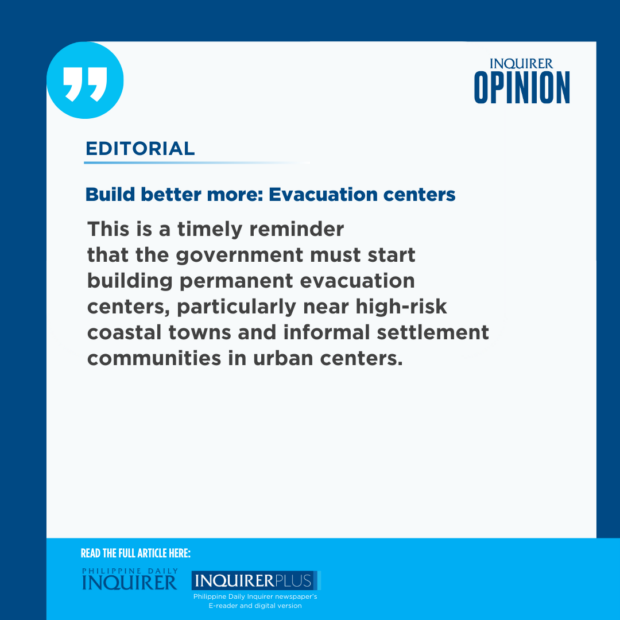Build better more: Evacuation centers

Hundreds of public schools are not joining the opening today of school year 2024-2025. The 832 public schools identified by the Department of Education (DepEd) are either inundated or are being occupied by residents displaced by the massive floods caused by Supertyphoon “Carina”-enhanced southwest monsoon, locally called “habagat.” Data from DepEd showed 452 of these schools are in Central Luzon, 225 in the National Capital Region, 85 in the Ilocos Region, 66 in Calabarzon, and four in the Soccsksargen Region.
Again, this is a timely reminder that the government must start building permanent evacuation centers, particularly near high-risk coastal towns and informal settlement communities in urban centers. For decades, the usual scenario after every natural or man-made disaster is for public schools to be used as temporary shelters for the tens of thousands of Filipinos displaced by storms, floods, earthquakes, volcanic eruptions, and even armed conflict. Usually lasting a few days to weeks, it sometimes takes months for these residents to safely return to their homes. For example, more than 2,000 families displaced by the eruption of Mayon Volcano in 2023 were allowed to go back to their houses after four long months.
Learning poverty
This practice must stop now simply because it interferes with the learning process and has exacerbated the learning poverty that placed Filipino children at the bottom ranking of the Programme for International Students Assessment in math, reading, and science.
Article continues after this advertisementThe DepEd is not oblivious to this fact. In a July 25 DepEd memorandum, newly appointed Education Secretary Sonny Angara directed that gymnasiums, learning and activity centers, auditoriums, and other open spaces in schools “should be utilized first” as emergency shelters and classrooms were to be the “last resort.” The use of schools as evacuation centers should also be “as brief as possible,” not exceeding 15 days, it said.
Last month, the Department of Social Welfare and Development (DSWD) also urged local government units to build evacuation centers designed for disaster response. “We know that there is a huge impact on the education sector whenever [schools] are [used for this],” admitted Leo Quintilla, special assistant secretary for disaster response and management of the DSWD. As of yesterday, the National Disaster Risk Reduction and Management Council reported that some 168,933 individuals were still in evacuation centers, many of them public schools.
Highest disaster risk
The World Risk Index, which assesses the disaster risk for all 193 United Nations-recognized countries and more than 99 percent of the world’s population, showed that in 2023 the Philippines led the list of countries with the highest disaster risk worldwide, followed by Indonesia and India.
Article continues after this advertisementHaving a high exposure to earthquakes, tsunamis, cyclones, coastal floods, riverine floods (when streams and rivers exceed their capacity and overflow the banks, spilling out into adjacent low-lying, dry land), drought, and sea-level rise, the Philippines also ranked high in lacking coping and adaptive capacities. Also according to the Philippine Atmospheric, Geophysical and Astronomical Services Administration, more tropical cyclones are entering the Philippine area of responsibility than anywhere else in the world, with an average of 20 a year and eight or nine of them crossing the Philippines. The peak of the typhoon season is July through October when nearly 70 percent of all typhoons develop.
Dedicated evacuation centers
Everyone knows that the permanent solution to this recurring problem is to build dedicated evacuation centers. The sad part is that no one seems to be paying attention. For instance, on June 9, 2015, or nine years ago, then Rep. Sherwin Gatchalian filed House Bill No. 5867 seeking to establish an evacuation center in every municipality and city in the country and ensure the structural capacity of evacuation centers.
All these proposed legislation sought to establish evacuation centers to provide immediate and temporary accommodation for evacuees or people displaced from their homes due to human-induced disasters, calamities, or other emergency events such as fires, or outbreaks of diseases. A key feature is the need for structural integrity and building capacity for the evacuation centers. Under the proposed bills, these should be “disaster-resilient, built with sturdy materials, constructed and designed to withstand super typhoons or wind speeds of at least 300 kilometers per hour, and seismic activity of at least 8.0 magnitude.”
Does the government really need legislation to do something it should have done a long time ago? Of course not. Does it have the money? Of course. It can start today using the excess funds of agencies and state-owned firms that the Department of Finance ordered moved to the national treasury to finance unprogrammed appropriations. This will require only a good sense of prioritization and political will.
(Note: Inquirer’s print edition stated that 979 public schools had to delay their opening. The Department of Education updated the figures late Sunday night.—Ed.)
















